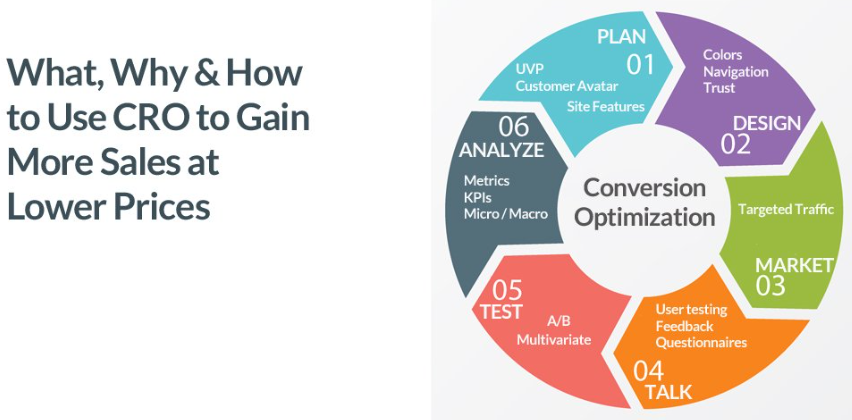I’m going to kick things off by getting down to brass tacks with some conversion rate optimization Pointers— commonly known as CRO.
At its core, CRO is the practice of increasing the percentage of users who take a desired action on your website.
That could mean making a purchase, signing up for a newsletter, or filling out a contact form. It’s a pivotal part of digital marketing that directly affects your bottom line.
Now, CRO isn’t just about tweaking buttons and boosting sales. It’s deeply intertwined with user experience and business growth.
A well-executed CRO strategy can lead to a smoother site journey for visitors, resulting in higher satisfaction and repeat business.
Quality CRO integrates seamlessly with the principles of Experience, Expertise, Authoritativeness, and Trust (E-E-A-T).
By focusing on providing a top-notch user experience that demonstrates your knowledge and reliability, you not only convert more visitors but also build a loyal customer base.
To understand how effective your CRO efforts are, you need to track certain metrics: conversion rates, of course, but also bounce rates, average session duration, and goal completion rates, to name a few.
These tell a story about where your site excels and where there’s room for improvement.
With those benefits and basics in mind, you’re going to find out how integral knowing your audience is.
Crafting a user-centric CRO plan isn’t just beneficial; it’s necessary. By diving into your audience’s preferences, behaviors, and needs, you create a CRO strategy that resonates on a deeper level.
That leads us straight into the next step: analyzing your audience. This is where you can create a plan that doesn’t just function well but feels like it’s been custom-made for each visitor.
Believe me, when it comes to boosting those conversion rates, a tailored experience is king.

Analyzing Your Audience: Creating a User-Centric CRO Plan
You’re going to find out about the key role audience research plays in constructing a successful CRO strategy. This isn’t just about looking at numbers; it’s also about getting into the heads of your users.
After all, to enhance your website’s conversion rate, you need to understand the people behind the clicks.
Utilizing user feedback and behavior is a bit like detective work. You’ll be searching for clues in the data to help you understand what your audience really wants.
Maybe it’s more informative product descriptions, easier navigation, or quicker checkout processes that they are silently crying out for.
By listening and responding to these needs, you’re likely to see a direct impact on conversions.
Segmentation and personalization can make or break your CRO efforts.
By tailoring user experiences based on demographics, interests, or past behavior, you demonstrate that you’re not just throwing content into the void but addressing specific needs and pain points.
Tailoring experiences can lead to a significant uptick in engagement and, by extension, conversions.
Building a connection with your users is crucial and a well-crafted, empathetic content strategy is the bridge.
This includes language that resonates, addressing customer anxieties, and reinforcing that you’re there to solve problems—not just sell a product or service.
I’ll take you through case studies of companies that have nailed this audience-centric approach.
These aren’t just hypothetical successes; these are real companies seeing real results by putting their users first in their CRO strategies.
Leveraging Design and Usability for Higher Conversions
You might be wondering why design and usability are so crucial for conversion rate optimization. Well, it’s simple: they play a massive role in how users interact with your site.
An intuitive design isn’t just about looking good; it’s about creating a seamless path for users to complete their desired actions without any hassle.
So, what does an effective website navigation look like? It’s clear, logical, and anticipates user needs.
Think of your site as a map; users should be able to find their destination quickly and easily.
Missteps in information architecture can lead users astray, increasing frustration and decreasing the likelihood of conversion.
Mobile users are everywhere, and catering to them is no longer optional. A mobile-friendly design ensures that users on their phones or tablets have just as great an experience as those on desktops.
If your site isn’t responsive or easy to navigate on a small screen, you’re inevitably turning away potential conversions.
Accessibility is another non-negotiable aspect of design.
By ensuring your website is accessible to all, including those with disabilities, you’re not only expanding your potential audience but also showing that your brand values inclusivity.
Features like screen reader compatibility and keyboard navigation options can make a world of difference.
And let’s talk about A/B Testing. This is a method where you compare two versions of a webpage to see which one performs better.
It allows you to make data-driven decisions about even the smallest design elements, like button colors or the placement of your CTAs. A/B testing is your secret weapon in refining user experience for better conversion rates.
Optimizing Content for Conversions: Going Beyond SEO
So, you’ve got a handle on SEO. Your website is receiving traffic, but now comes the next challenge: how do you convert more of those visitors into customers or clients?

This isn’t just about keywords or search engine rankings; it’s also about the content’s ability to engage and persuade.
One potent weapon in your arsenal should be your calls-to-action (CTAs). They need to be clear, compelling, and evocative of the response you’re seeking.
Asking ‘What do I want my visitor to do next?’ helps in crafting CTAs that steer them exactly where you want them to go.
Now, just producing high-quality content isn’t enough. You need to ensure that it resonates with your audience on a personal level.
That means understanding their needs, pains, and what they stand to gain—addressing the ‘What’s in it for me?’ from their perspective will boost your content’s conversion potential.
In my opinion, weaving E-E-A-T into your content should be non-negotiable if you’re looking to establish trust and authority.
Showcasing expertise through in-depth knowledge, backed by genuine authoritativeness, and anchored in trustworthiness opens doors to higher conversion rates.
I’d love to point you to some real-world examples. Various case studies have demonstrated that carefully strategized content, which prioritizes user needs and integrates authoritative sources, can result in significant upticks in conversions.
Measuring Success and Continuously Improving Your CRO Efforts
Now, you’ve got a solid grasp on the elements of conversion rate optimization, but remember this is an ongoing process.
Your work isn’t done once you’ve implemented the changes; the real magic happens when you measure the impact and iterate.
You’re going to find out about the essential KPIs for CRO like click-through rates, bounce rates, and conversion paths.
These metrics tell the story of where and how your strategies are succeeding or need adjustments.
Analytics are your best friend in this game. They provide the insights you need to refine your approach and keep your strategies aligned with user behavior and preferences, which, as you know, can change like the wind.
Don’t worry too much about setbacks. In the world of CRO, every ‘failure’ is just another stepping stone to success. It’s all about learning, tweaking, and improving.
Adopting an iterative approach to CRO is a commitment to perpetual improvement. It’s choosing to embrace each cycle of testing, analyzing, and optimizing.
That’s how you turn satisfactory conversion rates into remarkable ones. After all, perfection is not a destination; it’s a journey.
Success Story On Conversion Rate Optimization
One memorable experience I’ve encountered with Conversion Rate Optimization (CRO) involved a client in the e-commerce industry.
They were struggling to convert visitors into customers despite having significant traffic to their website.
After conducting a thorough analysis of their website and user behavior, we identified several areas for improvement.
One major issue was the lack of clear call-to-action (CTA) buttons and confusing navigation, which made it difficult for users to find what they were looking for.
We implemented a series of A/B tests to optimize the website’s design, copy, and user experience.
This included redesigning the layout to highlight key products, simplifying the navigation menu, and making CTAs more prominent and compelling.
Over the course of a few weeks, we closely monitored the results of the tests and made adjustments based on the data.
To our delight, we started to see a significant increase in conversion rates across the board.
Not only did the conversion rates improve, but the client also saw an uptick in sales and revenue.
This experience highlighted the power of CRO and the importance of continually testing and refining to enhance the user experience and drive business results.
It was incredibly rewarding to see the positive impact our efforts had on the client’s bottom line.

Pros of Conversion Rate Optimization (CRO):
- Increased Conversions: By optimizing your website or landing pages for better user experience, you can significantly increase conversion rates, leading to more sales, sign-ups, or other desired actions.
- Better ROI: CRO focuses on improving existing assets rather than investing in new traffic, which can lead to a higher return on investment (ROI) for your marketing efforts.
- Enhanced User Experience: Implementing CRO strategies often involves improving website usability, navigation, and overall user experience, which can result in happier and more engaged visitors.
- Data-Driven Decisions: CRO relies on data analysis and testing to make informed decisions, allowing you to continually refine and improve your marketing efforts based on real user behavior.
- Competitive Advantage: By consistently optimizing your conversion funnel, you can stay ahead of competitors and maintain a competitive edge in your industry.
Cons of Conversion Rate Optimization (CRO):
- Time-Consuming: Implementing CRO strategies and conducting A/B tests can be time-consuming, requiring ongoing effort and resources to achieve meaningful results.
- Requires Expertise: Effective CRO requires a deep understanding of analytics, user behavior, and testing methodologies, which may necessitate hiring specialized talent or investing in training.
- Potential for Misinterpretation: Drawing accurate conclusions from CRO experiments requires careful interpretation of data, and incorrect assumptions can lead to ineffective optimizations.
- Risk of Negative Impact: Poorly executed CRO experiments or misguided optimizations can potentially harm user experience and decrease conversion rates if not properly monitored and managed.
- Limited Scope: While CRO can improve the performance of existing pages or funnels, it may not address broader issues related to product-market fit, brand awareness, or overall marketing strategy.
Conclusion On Conversion Rate Optimization Pointers
In conclusion, Conversion Rate Optimization (CRO) is not just about tweaking buttons or boosting sales; it’s a holistic approach to enhancing user experience and driving business growth.
By focusing on providing a seamless journey for visitors and understanding their needs through audience analysis, segmentation, and personalization, you can significantly improve conversion rates.
Effective CRO strategies leverage design, usability, and accessibility to create intuitive experiences across all devices.
A/B testing allows for data-driven decision-making, refining user experience elements for better conversion rates.
Optimizing content goes beyond SEO, emphasizing the importance of compelling calls-to-action and user-centric messaging that resonates with the audience’s needs and desires.
Integrating the principles of Experience, Expertise, Authoritativeness, and Trust (E-A-T) into content further builds trust and credibility, leading to higher conversions.
Measuring success and continuously improving CRO efforts through analytics and iterative testing is essential for sustained growth.
Every setback is an opportunity to learn and refine strategies, ultimately leading to remarkable conversion rates and business success.
One success story illustrates the transformative impact of CRO, where strategic analysis, A/B testing, and iterative improvements led to significant increases in conversion rates, sales, and revenue for an e-commerce client.
In the dynamic landscape of digital marketing, embracing CRO as an ongoing process is key to achieving and maintaining success.
As you embark on your CRO journey, remember that perfection is not a destination; it’s a journey of perpetual improvement.
Wealthy Affiliate offers a comprehensive platform that equips users with the knowledge and tools to optimize conversion rates effectively.
Through its extensive training resources, members gain insights into the intricacies of conversion rate optimization (CRO), learning techniques to analyze user behavior, identify pain points, and refine strategies for enhanced engagement and sales.
Additionally, Wealthy Affiliate provides access to cutting-edge tools and technologies, empowering users to conduct A/B testing, track metrics, and implement data-driven improvements across their digital assets.
By leveraging the expertise and resources available within the Wealthy Affiliate community, individuals can elevate their CRO efforts, driving higher conversion rates and maximizing their online business potential.
Watch this short video
Video
Let’s Engage
As we wrap up our exploration of Conversion Rate Optimization (CRO), I invite you to join the conversation.
- Have you implemented any CRO strategies on your website?
- What challenges have you faced, and what successes have you experienced?
Your insights and experiences are invaluable not only to us but to fellow readers navigating their own CRO journeys. Whether you have questions, anecdotes, or tips to share, your voice matters.
Let’s continue the dialogue in the comments below. Together, we can exchange ideas, learn from each other’s triumphs and setbacks, and collectively elevate our CRO game.
Don’t hesitate to leave your thoughts—it’s through collaboration and community that we can truly unlock the full potential of Conversion Rate Optimization. Can’t wait to hear from you!
Earl
Email; earl@entrepreneurprograms20.com

CRO is definitely something I need to study more fully and your post here is a great site. I’m just now getting into SEO more and working that side of my website. Soon, I will be at the place where I will have a call to action. I know email addresses will be a big factor and then comes asking my customers to click on that affiliate link. You have a good step by step that shows how having a CRO strategy is important and then analyzing the data on the back side. I am sure I will come back to your site often.
Yes you certainly do, it s important to your business. Thanks for your comment Scott